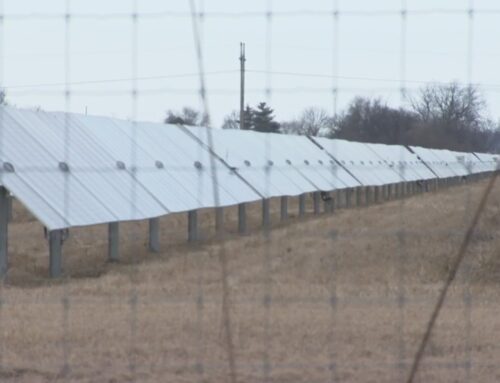Climate and environment updates: Global energy demand skyrocketed in 2024: Report
March 25, 2025
The climate crisis is not a distant threat; it’s happening right now and affecting what matters most to us. Hurricanes intensified by a warming planet and drought-fueled wildfires are destroying our communities. Rising seas and flooding are swallowing our homes. And record-breaking heat waves are reshaping our way of life.
The good news is we know how to turn the tide and avoid the worst possible outcomes. However, understanding what needs to be done can be confusing due to a constant stream of climate updates, scientific findings, and critical decisions that are shaping our future.
That’s why the ABC News Climate and Weather Unit is cutting through the noise by curating what you need to know to keep the people and places you care about safe. We are dedicated to providing clarity amid the chaos, giving you the facts and insights necessary to navigate the climate realities of today — and tomorrow.
Latest Developments
As the planet gets warmer, the need for electric cooling continues to grow. And according to a new report from the International Energy Agency (IEA), it’s one of the main reasons global demand for energy spiked in 2024. The IEA found that air conditioning use, industrial production and the expansion of data centers resulted in the power sector, led by electricity, growing nearly twice as fast as the average rate over the past decade.
According to the report, over 80% of last year’s global energy demand increase came from emerging and developing economies. However, after several years of declines, even advanced economies, like the United States, saw demand growth in 2024.
Electricity use is growing so rapidly that it has reversed recent trends in energy consumption in advanced economies worldwide, IEA Executive Director Fatih Birol said in a statement.
Global heat waves, the growing fleet of electric vehicles and the construction of new data centers were all cited as contributing factors to the spike in electricity demand last year.
Global sales of electric cars accounted for one-fifth of all car sales in 2024, an increase of more than 25% from the previous year. Meanwhile, demand for electricity from new data centers, mainly in the United States and China, accounted for about 20% of the rise in electricity demand.
While all available energy sources are helping meet the global demand for energy demand, a growing supply of low-emission sources was able to cover most of last year’s increase. In 2024, 80% of the growth in global electricity generation was from renewable and nuclear sources, contributing to 40% of the world’s total electricity generation for the first time. Solar and wind accounted for 16% of the United State’s electricity, surpassing coal.
The report found that this significant shift to renewable energy sources has had a notable impact on limiting the annual rise in energy-related carbon dioxide emissions. In 2024, carbon dioxide emissions in advanced economies dropped to their lowest level in 50 years. Additionally, the deployment of solar, wind, nuclear, electric cars and heat pumps since 2019 now prevents 2.6 billion tons of carbon dioxide from being released into the atmosphere each year.
-ABC News meteorologist Dan Peck
If you’ve been losing sleep because of anxiety about our changing climate, you can now blame global warming for literally keeping you awake. A new study in Nature Communications suggests rising temperatures can make it harder for people to get a good night’s sleep.
Researchers analyzed 23 million sleep records from more than 214,000 adults living in mainland China. They found that when the average daily temperature increased by 18 degrees Fahrenheit, people were 20.1% more likely to get insufficient sleep. In addition, total sleep time dropped by nearly 10 minutes per night. Deep sleep, essential for physical and mental recovery, was the most affected, declining by 2.82%.
The study also suggests that by the end of the century, climate change-related sleep deprivation could increase by an average of 10.5%. If true, that would result in the average person losing more than 33 hours of sleep each year.
Light sleep and dream sleep also declined by over 2%. People older than 45, women, those with a BMI greater than 25 and people living in humid climates such as South, Central and Eastern China were at greater risk.
Participants wore a smart device for the study to monitor their heart rate, exercise and sleep patterns. And while the study looked at a large number of people, it didn’t include anyone from outside of China. It also assumed that outdoor temperatures reflected the actual sleep conditions without considering whether the person had an air conditioner.
According to the National Weather Service, extreme heat is the deadliest weather-related hazard in the United States, and children and adults over 65 are among the most vulnerable to heat-related illnesses and death.
-ABC News climate unit’s Matthew Glasser and ABC News medical unit’s Heya Batah, MD
The National Oceanic and Atmospheric Administration (NOAA) is out with its spring weather outlook, calling for above-average temperatures in the East and Gulf Coast regions and drought conditions in the Southwest.
From April to June, NOAA says warmer-than-average temperatures are likely for the southern part of the U.S. and across the Eastern seaboard. Central and south Florida, along with the areas stretching from the Texas and Louisiana coasts to southern Utah and eastern Nevada, have the highest chance of seeing a warmer-than-normal springtime.
Moderate to exceptional drought conditions will likely continue in much of the Southwest and the Rocky Mountains. NOAA also predicts that much of the western U.S. will get less rain than average, adding to their water woes.
There’s good news on the flooding front, however. NOAA’s National Water Center does not anticipate widespread flooding across the country. The agency says above-average temperatures and snowpacks far below normal significantly reduce the risk of major flooding.
As spring is typically the busiest time for tornadoes, NOAA is encouraging people in tornado zones to prepare for the upcoming season by reading up on how to stay safe during these extreme weather events.
-ABC News climate unit’s Matthew Glasser
The pilots and scientists who fly into hurricanes face a storm that has nothing to do with the weather. Called “hurricane hunters,” these crews fly into tropical cyclones and winter storms to collect data essential for forecasting a storm’s path, timing and strength.
Operated by the National Oceanic and Atmospheric Administration (NOAA) and the United States Air Force, these crews are now facing staffing and maintenance issues, according to a newly released report from the Government Accountability Office (GAO).
The report’s release comes as NOAA and the National Weather Service (part of NOAA) are facing staff reductions that have impacted various offices nationwide.
The GAO report details the critical role that the program plays in weather forecasting and storm preparation and says staffing and maintenance issues are forcing the cancellation of necessary missions.
Staffing shortages have impeded the completion of mission objectives, as hurricane hunter personnel face growing workloads, NOAA officials said, explaining that “the agency is often one illness or injury away from having to cancel missions.” The GAO also identified an aging aircraft fleet and an inadequate number of maintenance technicians as problems for the agency.
In 2023, all three of NOAA’s Hurricane Hunter aircraft were grounded due to maintenance issues as Hurricane Idalia threatened Florida in late August.
However, the report found that these issues weren’t the only reason flights were being canceled. Demand for hurricane hunter reconnaissance flights has increased in recent years, primarily due to the addition of atmospheric river missions on the West Coast, which were added in 2019. Very active Atlantic hurricane seasons in recent years is also a contributing factor.
The GAO published a list of recommendations aimed at improving operations. It suggested developing a process to better track personnel and manage maintenance requests and issues. The report also recommended that organizations perform staffing assessments to identify their current needs. Additionally, it noted that poor communication between NOAA and Air Force senior leadership has hindered the availability of reliable aircraft. NOAA and the Air Force said they agreed with the recommendations.
-ABC News meteorologist Dan Peck
The Trump administration may no longer be supporting renewable energy, but in 2024, the United States made significant strides with its energy source shift.
Last year, the U.S. generated a record amount of energy from solar and wind sources, enough to power the equivalent of more than 70 million average American homes, according to a new analysis of U.S. Energy Information Administration (EIA) data by Climate Central, a nonprofit climate research group.
In 2024, 756,621 gigawatt-hours (GWh) of electricity came from solar and wind, triple the amount generated a decade ago. Solar and wind combined accounted for about 17% of the country’s electricity generation.
In the United States, solar is now the fastest-growing source of electricity, with increases in solar generation reported across all 50 states and Washington, D.C., over the past decade, according to the analysis. California was the biggest solar energy producer in 2024, with Texas and Florida rounding out the top 3. Between 2023 and 2024, U.S. solar generation increased 27%.
Currently, 42 states produce electricity from wind, with 39 reporting an increase in wind generation over the past decade. Texas is the largest wind energy producer, accounting for about 28% of all wind generation in the United States last year. The next largest wind energy-producing state is Iowa. While the total amount of wind generation is significantly lower than in Texas, wind accounts for nearly two-thirds of all the electricity produced in the Hawkeye state.
-ABC News meteorologist Dan Peck
While frequent arctic blasts impacted much of the United States, meteorological winter ended up warmer than average, according to a new report from the National Oceanic and Atmospheric Administration (NOAA).
Across the contiguous United States, meteorological winter, which runs from Dec. 1 through the end of February, had an average temperature of 34.1 degrees Fahrenheit, running 1.9 degrees above average and ranking in the warmest third of NOAA’s historical record. Winter is now the fastest warming season for most of the country,
Winter precipitation across the Lower 48 was below average, making it the driest third of NOAA’s historical record. According to the latest U.S. Drought Monitor report released on Mar. 4, about 44.4% of the contiguous U.S. is experiencing drought conditions, an increase of about 2% since the beginning of February.
Alaska’s winter season temperature was 10 degrees Fahrenheit above the long-term average, ranking as the third-warmest in the 101 years of record for the state. The northern third of Alaska is part of the Arctic Circle, a region that is warming much faster than the global average.
To the south, Anchorage experienced its least snowiest winter on record with just 4.6 inches of snow falling. This broke the previous record set during the winter of 2015-2016 by nearly 3 inches. This year, the starting line of the world-famous Iditarod Trail Sled Dog Race was moved about 360 miles north, from Anchorage to Fairbanks due to a lack of snow.
While we cannot directly attribute this to human-amplified climate change, in a warming world, more precipitation will fall as rain instead of snow, according to the Fifth National Climate Assessment. And less reliable cold weather will make it increasingly difficult for the snow essential to winter activities, like the Iditarod, to stick around.
-ABC News meteorologist Dan Peck
It has been a frigid start to 2025 for much of the United States. However, globally, the planet’s long stretch of near-record to record-high temperatures has proved detrimental to global sea ice cover.
Global sea ice extent fell to its lowest recorded value in February, according to data analyzed by the Copernicus Climate Change Service. Last month also ranked as the third-warmest February on record for the planet.
Sea ice extent is the area of ocean covered by ice that’s at least 15% frozen. Global sea ice extent combines the values of the Arctic and Antarctic polar regions. The new record occurred because both regions experienced below-average coverage simultaneously, with Arctic sea ice cover dropping to a new record low for February, according to the report.
The Arctic region is warming much faster than the global average. After acting as a carbon sink for thousands of years, the area has become a source of carbon dioxide emissions due to rapidly warming conditions and increasing wildfire activity, according to a recent report by the National Oceanic and Atmospheric Administration.
While last month ranked as the third-warmest on record for the planet, it registered more than 1.5 degrees Celsius warmer than the pre-industrial average (1850-1900), making it the 19th of the last 20 months to exceed the warming threshold established in the 2015 Paris Climate Agreement.
Exceeding the 1.5 degree Celsius threshold temporarily is not seen as a failure to limit warming under the agreement since it looks at the climate average over multiple decades.
February was the first month that has not been the warmest or second-warmest on record since June 2023. A temporary decline in global temperature records was anticipated due to the current La Niña conditions in the equatorial eastern Pacific Ocean, which usually leads to a decrease in the global average temperature.
However, this pause will likely not last long as the overall long-term global average temperature trend keeps going up, fueled by human greenhouse gas emissions.
-ABC News meteorologist Dan Peck
If you’re a seasonal allergy sufferer, you better stock up on your meds. A new study from Climate Central found that allergy season is starting earlier, lasting longer and becoming more severe because of warming trends amplified by climate change.
Using data from NOAA, the nonprofit climate research group studied the warming trends of 198 cities from 1970 to 2024. It found that 87% now have a longer freeze-free growing season. Extended periods of above-freezing weather give plants more time to grow, which results in more allergy-inducing pollen.
Climate Central said that, on average, 172 cities had their freeze-free season increase by 20 days. According to data, cities in the Southwest and Northwest had the most significant increase in above-freezing days. Allergy season increased the most in Reno, Nevada (96 more days); Las Cruces, New Mexico (66 more days); Medford, Oregon (63 more days); and Tupelo, Mississippi, and Myrtle Beach, South Carolina (both with 52 more days).
Climate change is not only increasing the length of allergy season, but it’s also making it more intense, according to studies. A study in Allergy, Asthma & Immunology Research found that higher levels of CO2 emissions can boost pollen production in plants, specifically ragweed and grasses. And a 2022 study in Nature Communications predicted that by the end of the century, we could experience an up to 200% increase in pollen production.
According to the Centers for Disease Control and Prevention, 1 in 4 adults and 1 in 5 children suffer from seasonal allergies in the United States.
-ABC News climate unit’s Matthew Glasser
Electricity is essential for running most of our daily lives, and a recent report from the International Energy Agency (IEA) predicts that demand for it will continue to rise in the coming years. The IEA estimates that increases in industrial production, more air conditioning use and the expansion of global data centers will drive the fastest growth in global electricity demand, with an annual increase of around 4% through 2027.
Since 2009, electricity demand in advanced economies, like the United States, has remained relatively unchanged due to increases in efficiency and industrial restructuring. However, the recent expansion of high-consumption items like electric vehicles and data centers has triggered a resurgence in demand. Global electricity demand saw a sharp increase of 2.5% in 2023 and nearly doubled to 4.3% in 2024.
While advanced economies still consume most of the world’s total electricity, emerging and developing economies, led by China, are expected to account for 85% of global demand growth through 2027. According to the report, China is projected to account for more than half of these gains, with a year-over-year demand increase of about 6%.
The report emphasizes that the anticipated increase in consumption is unlikely to hinder global sustainability efforts because rapidly growing low-emission energy sources, such as renewables and nuclear energy, are expected to achieve record-high electricity generation and offset the additional global demand. Renewable energy sources, including solar wind and hydropower, are forecast to meet about 95% of the global electricity demand growth through 2027.
According to the IEA, renewable and nuclear energy sources are expected to surpass coal this year, accounting for more than one-third of global electricity generation. Because coal is a significant pollutant and the largest source of energy-related carbon dioxide (CO2) emissions, climate organizations and environmental groups have long called for phasing it out as an energy source.
-ABC News meteorologist Dan Peck
Last year was not only the warmest on record, but also the first that the planet’s global average surface temperature measured 1.5 degrees Celsius (2.7 degrees Fahrenheit) warmer than the pre-industrial average from 1850-1900. That’s according to data analyzed by the Copernicus Climate Change Service (C3S).
That wasn’t the first time that the planet has hit the 1.5 degrees Celsius warming threshold in recent years. The 12-month global temperature average from February 2023 to January 2024 also crossed this threshold. And for the first time on record, 12 straight calendar months surpassed the warming threshold from July 2023 to June 2024.
A cap of 1.5 degrees Celsius was set as the goal for the Paris Agreement because most scientists believe it’s the threshold for avoiding the worst impacts of climate change. Now, two new studies are warning that we are unlikely to meet this goal.
New research published in the journal Nature Climate Change found it’s significantly likely that the world has already breached the 1.5 degree target. The study’s authors investigated possible long-term warming scenarios based on various levels of greenhouse gas emissions and examined historical climate data, recent observations and modeling projections.
Another recent Nature Climate Change study analyzed warming trends over past decades and then applied their findings to future climate modeling projections. The authors concluded that the world would now only avoid exceeding the 1.5-degree goal by implementing very stringent emissions cuts.
Having one year, or even several years, that exceed the 1.5 degrees Celsius threshold isn’t considered a failure to meet the Paris Agreement’s goal since the agreement looks at the global temperature average over multiple decades. And while the 1.5 degrees Celsius threshold is largely symbolic, every fraction of a degree of warming increases the risk and compounds the challenges we face.
-ABC News meteorologist Dan Peck and ABC News climate unit’s Matthew Glasser
Search
RECENT PRESS RELEASES
Related Post




